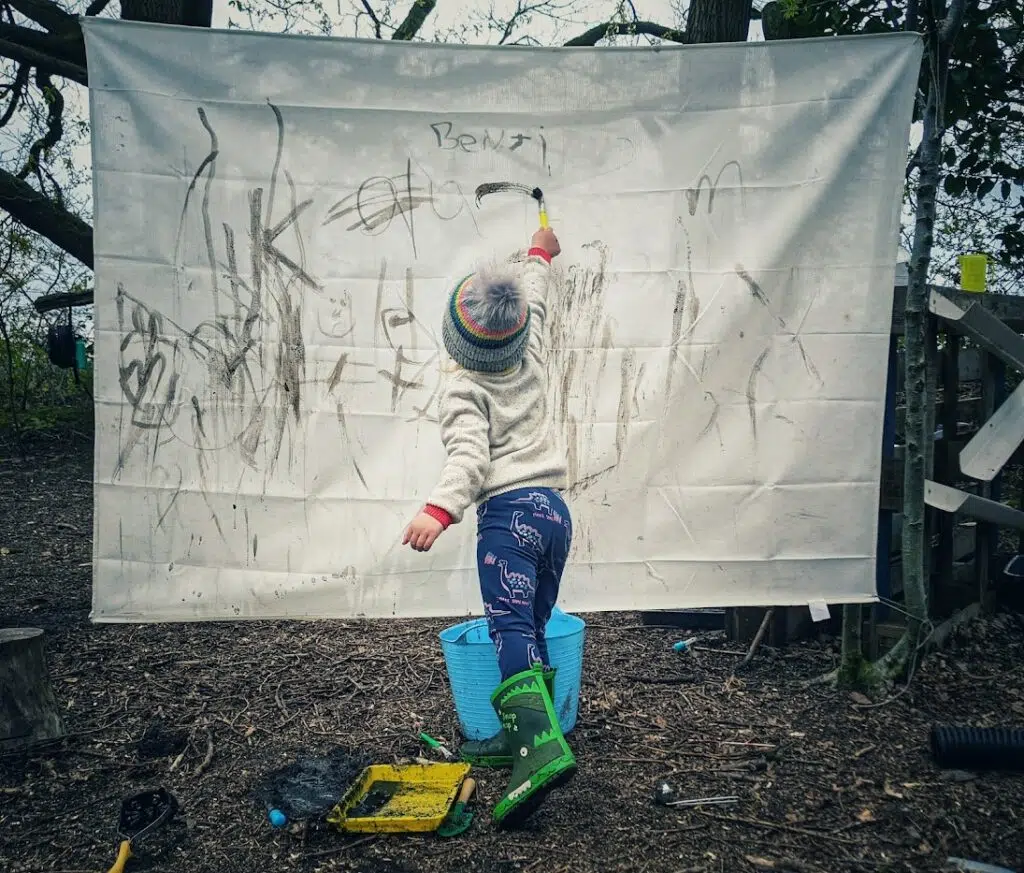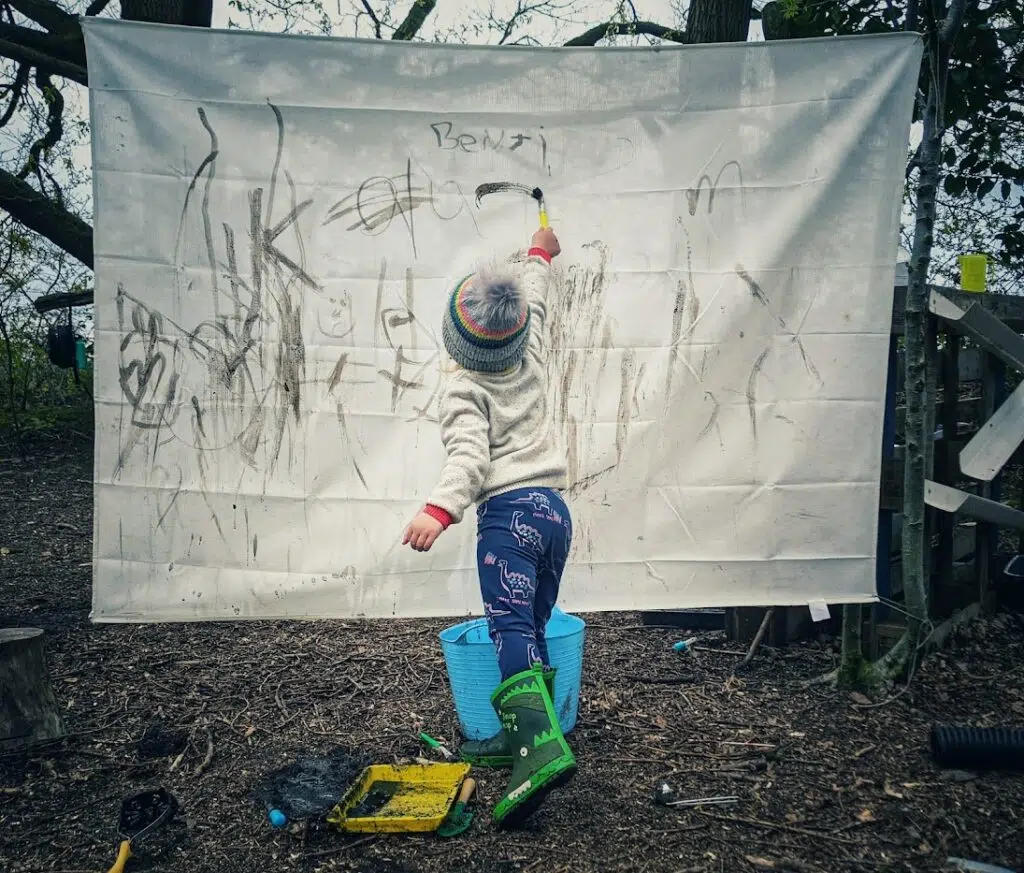Fantastic…oozy…gooey…squelchy…sloppy…mud! Is there anything greater when you’re in preschool?
I doubt it!
I’ve watched kids experiment with all kinds of mud experiences and activities over the last decade, and in this post, I’ll share my all-time favorite 17 mud activities for preschoolers! Let’s get straight into it…

1. Mud Hedgehogs
Who said mud can’t create beautiful art, right?
These hedgehogs are really gorgeous – plus they’re pretty simple for even very young kids to create (no problem at all for preschool!)
What you do, is get a big ball of mud. Shape it into what will be the hedgehog’s body (just a big blob is fine!)
Now it’s time to find some prickles!
You can use all sorts of things for these prickles. This is essentially a scavenger hunt-style activity. The kids are going to go off and find whatever you’ve got in the environment that could be used as a prickle.
If you’ve got a nice leafy outdoor environment, then sticks and twigs are the best options.
Here’s a picture of some fantastic hedgehogs that were made at Wilding’s Forest School:

2. Potions
So many kids are inspired by magic, witches, wizards, and all things spooky and other-worldly.
Throw a bit of mud into this mix, and what do you get – magic mud potions!
There is no real right or wrong way of making these, and the kids will often find their own way of doing it (which is great!).
What I would suggest is to supply some of the following resources:
- A pestle and mortar
- Large bowls
- Flowers
- Bark
- Spoons and ladles to stir
- Magic wands!
Children can use the water from whatever source you have, earth, mud, and whatever else you have on hand.
Stir…make spells…make incantations…the amount of learning in making potions is off the charts!
3. Mud Pies
The quintessential mud activity, this one!
Pretty much all you need is:
- Some earth or mud
- Water
- Spoons or forks to stir
- Some kind of container
- Cutlery/bowls to serve the finished product!
Basically, mix the earth with enough water to create mud! This is the main challenge of the activity.
Then squish it all together into a big muddy ball. Voila! Your mud pie is served.
Kids love serving this up on bowls with knives and forks and all the trimmings.
4. Making Marks
Mud is a fantastic writing and drawing medium. It can be a good way of getting more reluctant children to make marks.
You can make marks with mud in lots of ways, such as:
- Drawing in the mud with sticks
- Using mud on paint brushes and writing/drawing with it
Here is a fantastic example of a setting using a big sheet, and kids drawing on it with mud using paint-brushes:

5. Mud Slides
Some good-quality water-proof clothes are required for this (as you can probably imagine).
The kids basically need to be completely covered head to toe in water-proofs, with wellies on their feet.
You need some kind of slope or mini hill for your mud-slide. Be warned – when you have turned it into a mudslide there’s pretty much no going back. The mudslide is going to be there for the foreseeable.
So, if you’re going to create one, just keep this in mind! You have to commit.
To create a mud-slide on your slope, get a hose pipe and leave it at the top of the mini-hill. Even if the area is covered in lush green grass to start with, lots of trampling around and rolling down this hill with the hose pipe on should make it pretty muddy quite quickly.
When you get to the point where the hill is pure mud, the slide becomes so much quicker!
In engaging with a mudslide, children are learning many things, including:
- Experiencing speed and velocity
- They are experiencing a sense of danger and being out of control
- They are exploring their bodies and their physicality
- They are having fun!
Mudslides are a kind of risky play. Risky play has multiple benefits for kids. (I wrote a whole article about this that you can read here).
6. Car Wash With Toy Cars
Now for a more small-scale mud activity – car washes!
There are lots of ways of doing this, but I tried it with some toy cars. This is a great activity for kids that are particularly fascinated with vehicles anyway.
In a muddy area, quite simply put those cars. The kids will drive them around and they’re going to get pretty muddy very quickly!
For the car wash, provide:
- Bowls of water
- Brushes (like tooth-brushes)
- Small sponges
- Tiny cloths
I’d go for cloths and sponges that are literally only about an inch wide.
This is essentially a really great fine motor activity!
Tiny washing movements of the fingers and hands make it really engaging, and you get loads of fine motor development thrown in.
7. Mud Pits
I’ve seen a lot of forest schools have mud pits these days, and what an exciting resource they are!
It’s basically a bordered area containing…you guessed it – mud!
You can have two types – one where the children don’t get in but interact with objects in the mud (like loose parts, stones, sticks, diggers, or other resources). Or, you can have the type where the children get in!
The latter type is definitely my favorite!
Once again, resilient water-proof clothes are required!
I’ve seen many other resources in this kind of mud-pit, such as:
- Crates
- Sticks
- Planks
- Stone
- Spades
- Containers and water
- Loose parts such as pinecones
Children can construct obstacle courses, streams, walkways, sculptures, and so much more!
8. Digging Trench
This is a similar idea to the mud pit. Just with the trench, the emphasis is on digging!
I visited a trench recently that was about four feet deep, ten feet long, and about three feet deep.
Loads of kids were in there, digging, and making it deeper and wider!
To start a trench, you need to dig out a big section first. Either using a few volunteers with shovels (or a digger), get the general trench shape started. Lots of water to completely saturate the ground helps with this process.
From then on, it’s over to the kids to make it deeper.
Digging has so many benefits for children. It strengthens their hands and arms and improves their gross and fine motor.
9. Making Streams
A source of water around mud or earth can provide all sorts of interesting play experiences.
Some good water sources might be:
- A water butt
- An outside tap
- A water trough
Children enjoy using containers to transport water, and create streams on the floor, by pouring water into their desired place.
They can:
- Use spades to dig out stream beds
- Create dams
- Spread out the streams into rivulets
10. Mud Painting With Natural Brushes
You can paint using mud with all sorts of different brushes!
One good way is to attach different natural objects onto sticks using rubber bands.
For example, try sticking on all different kinds of leaves, plants, or even things like corks or feathers.
Using very sloppy mud, you can then ‘paint’ with these brushes on big surfaces such as wallpaper.
11. Mud Spa With Toy Figures
Pretty much all you need for this are some toy figures that are on a spa day! (Lucky them).
They get the full works of a mud facial, mud massage, and all the rest of it.
Lots of washing off later is all good!
12. Mud Bathing
‘Forest bathing’ is all the rage these days, right!? If you’ve not heard of it, it’s basically taking your shoes and socks off in the forest, and ‘bathing in’ (making contact) with the grass, earth, moss, leaves, and all the rest of it.
You can most definitely do this with mud!
All you need is a mud-pit or a big trough of mud. The kids sit around the outside, with their feet in the mud.
It’s a beautiful mindful experience.
You can talk about what it feels like, and describe the experience.
But the real emphasis should be on the experience itself! Feeling the muddiness of mud!

13. Constructing With Mud
Mud of the right consistency can be used as a construction material!
You basically need it not too sloppy, but squidgy enough to manipulate.
Kids can create all sorts of things – castles, bridges, houses, superhero cars, animals…you name it!
It can be used alongside many other natural loose parts, such as:
- Sticks
- Pebbles
- Shells
- Corks
14. Mud Printing
Here’s a wonderfully messy activity for you – the dreaded mud printing!
You need lots of really oozy, sloppy, watered-down mud for this one.
Also, you need something to print with. Some options are:
- Potatoes cut into shapes
- Sponges of different sizes/shapes
- Natural materials with textures, such as bark, big leaves, or flowers (this is my favorite option)
Press whatever material you’re using into the mud, and then print it onto the big paper.
15. Mud Kitchens
A mud kitchen is probably the most well-known mud activity, so I thought I’d better include it.
Mud kitchens come in all sorts of shapes and sizes, and are essentially stations where children can ‘cook’ with all sorts of utensils and, of course…mud!
Many mud kitchens will include:
- Pots and pans
- Ladles and spoons
- Cutlery
- Bowls
- A pestle and mortar
- Access to water
- Access to mud
Mud kitchens are one of the ultimate early learning areas, and a staggering amount of learning takes place in them.
16. Weighing Objects (With Mud Balance)
You’ve probably seen these kinds of balances. They have a big wooden arm, with two buckets on either end.
If you love a bit of DIY, then this is a great project for you!
They are a really simple tool to use to measure the weight of the objects in your environment.
And there’s one fantastic and completely free substance to weigh them with…why mud of course!
17. Mud Mashing
This is a great activity for hand and arm strength!
You need some potato mashers for this! You also need lots of oozy mud.
It’s a pretty simple concept – just mash that mud! Children can add more water as well.
It’s all about experimenting with form, and consistency, and, well…just having fun mashing as well.
Final Thoughts
Mud provides so many exciting learning experiences, it really is kind of unreal!
If you’ve found this article useful, another one you’ll definitely enjoy is Forest School Craft Activities here.
